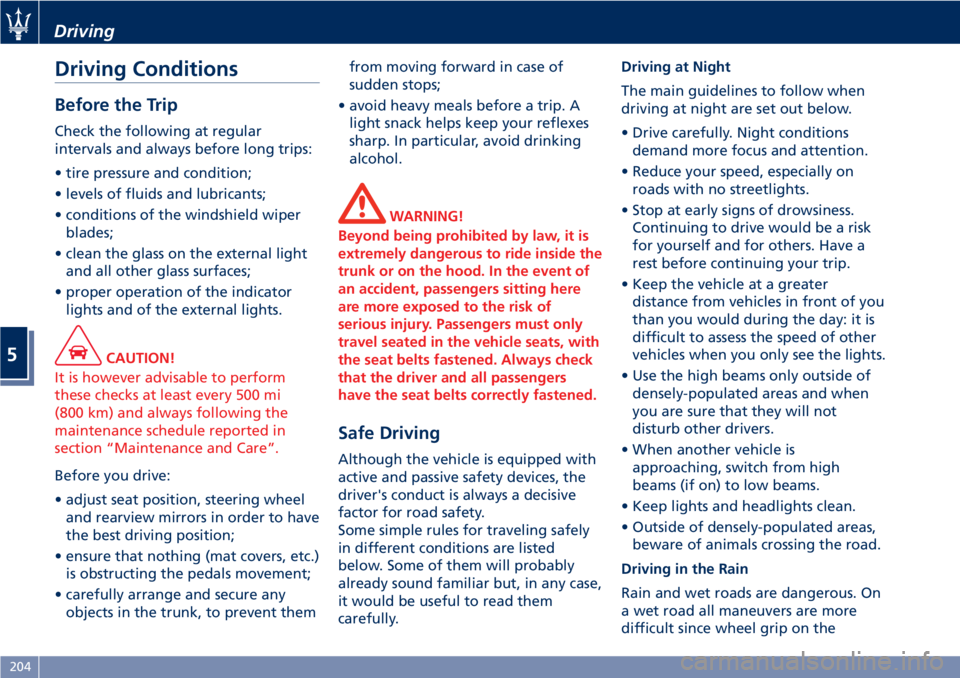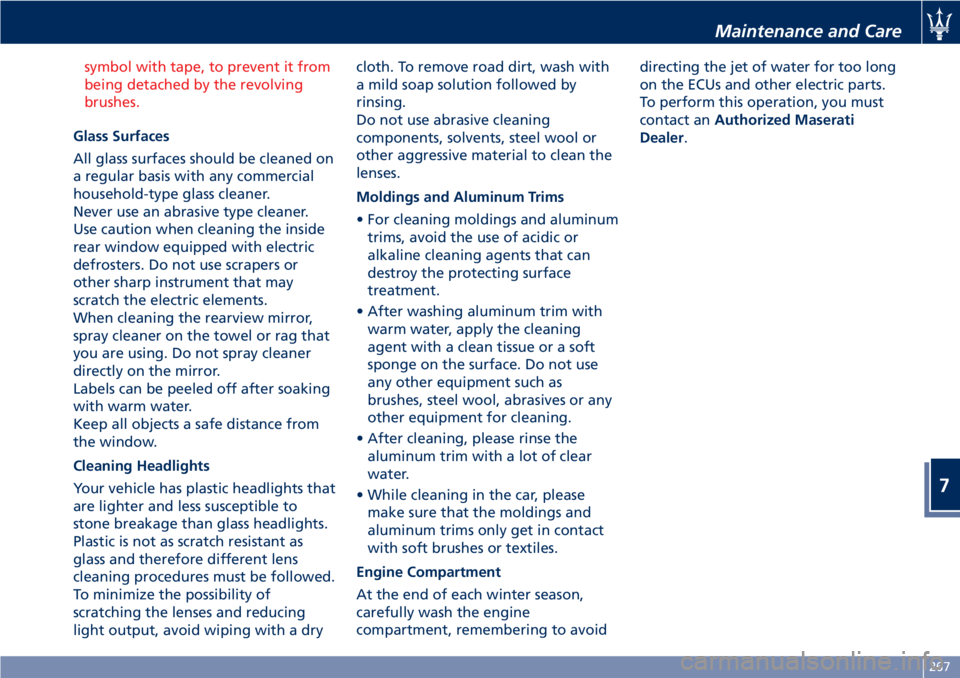2020 MASERATI GRANTURISMO CONVERTIBLE rear view mirror
[x] Cancel search: rear view mirrorPage 144 of 296

Audio System
The vehicle is equipped with an audio
system that offers superior sound
quality, higher sound pressure levels
and reduced energy consumption.
The system maximizes the amplifier
and speaker technology delivering
substantially higher components and
system efficiency.
Premium System
The vehicle is equipped with a
“Premium” sound system which
features 9 speakers and can develop a
sound output of 900 W.
System Components
The "Premium" system includes:
1One 3.1 in (80 mm) Centerfill
positioned centrally on the
dashboard.
2Two 1 in (25 mm) Tweeter
positioned in the passenger
compartment, near the outside
rearview mirrors.
3Two 6.5 in (165 mm) Mid-Woofer
on each of the door panels.4One Sub-Woofer powered by
two amplifiers and housed in a
central position between the two
rear seats.
5Two 6.5 in (165 mm) Mid-Woofer
on the side panels of the rear
seats.
6Two 1 in (25 mm) Tweeter on the
side panels of the rear seats.
712-Channel located on inner
left-hand side of trunk
compartment.
Dashboard Instruments and Controls
4
140
Page 150 of 296

and rearview mirror position
storage).
The volume can be set to 7 levels
identified by numbers from "1" to
"7" by pressing the "+" or "–"
softkey.
•Light Sensor
This feature allows to adjust the
sensitivity of the twilight sensor for
turning on the lights.
The feature can be set to 3 levels:
"Low", "Medium" (default setting)
and "High".
•Speed Limit
This feature allows to set a speed
limit and activate an alarm signal
which will sound when themaximum speed limit set is
exceeded.
Checkmarked the softkey to enable
the feature.
Press then the "+" or "–" softkey to
increase or decrease the speed limit.
Each touch increases/decreases the
value by 5 units.
Lights
Press the “Lights” softkey to set the
following modes.
•Daytime Lights(DRL, for
versions/markets where provided)
If activated, this feature allows the
automatic switching on of the DRL
upon switching off of the position
lights and vice versa. When the
position lights switch on, the DRL
switch off.
See “Lights” in section
“Understanding the Vehicle” for
further information.
Doors & Locks
Press the “Doors & Locks” softkey to
set the following modes.
•Auto Door Locks(Autoclose)
When this feature is selected, all
doors will automatically lock whenthe vehicle is in motion. The feature
can be set to “On” or “Off”.
•Independent Trunk Lid Unlocking
When this feature is selected and
checkmarked, only the trunk
compartment lid remains unlocked
and can be opened by pressing the
button between the license plate
lights.
When there is not checkmark, the
trunk lid unlocking follows the logic
of the doors.
•Key Fob Unlocks
By selecting this feature you may set
up only the driver's door or all doors
mode will unlock on the first press
of the
button on the radio
control case (key fob). When "Driver
Door" is selected, you must press the
key fob
button twice to unlock
also the passenger’s door. When
Dashboard Instruments and Controls
4
146
Page 155 of 296

Air Conditioning Controls
The vehicle is equipped with an
automatic dual-zone air conditioning
system that allows to adjust separately
the air temperature and the airflow
distribution in the left and in the right
zone of the passenger compartment,
according to the requests of the driver
and the front passenger.
A humidity sensor, positioned on the
inner surface of the windshield, over
the rearview mirror, allows the A/C
system to prevent/ eliminate fogging
of the windshield and side windows.
The best efficacy in preventing
fogging is obtained by selecting the
AUTO function, described later.
A dual zone solar sensor, positioned
on the center of the dashboard upper
surface, helps to achieve the best
comfort in presence of solar radiation.
CAUTION!
To ensure proper functioning of the
solar sensor, do not apply adhesive
parking stickers, etc. in the checking
area between the sensor and the
windshield. Therefore, keep the
windshield and the sensor clean toprevent accumulation of dust or other
impurities.
Dashboard Instruments and Controls
4
151
Page 208 of 296

Driving Conditions
Before the Trip
Check the following at regular
intervals and always before long trips:
• tire pressure and condition;
• levels of fluids and lubricants;
• conditions of the windshield wiper
blades;
• clean the glass on the external light
and all other glass surfaces;
• proper operation of the indicator
lights and of the external lights.
CAUTION!
It is however advisable to perform
these checks at least every 500 mi
(800 km) and always following the
maintenance schedule reported in
section “Maintenance and Care”.
Before you drive:
• adjust seat position, steering wheel
and rearview mirrors in order to have
the best driving position;
• ensure that nothing (mat covers, etc.)
is obstructing the pedals movement;
• carefully arrange and secure any
objects in the trunk, to prevent themfrom moving forward in case of
sudden stops;
• avoid heavy meals before a trip. A
light snack helps keep your reflexes
sharp. In particular, avoid drinking
alcohol.
WARNING!
Beyond being prohibited by law, it is
extremely dangerous to ride inside the
trunk or on the hood. In the event of
an accident, passengers sitting here
are more exposed to the risk of
serious injury. Passengers must only
travel seated in the vehicle seats, with
the seat belts fastened. Always check
that the driver and all passengers
have the seat belts correctly fastened.
Safe Driving
Although the vehicle is equipped with
active and passive safety devices, the
driver's conduct is always a decisive
factor for road safety.
Some simple rules for traveling safely
in different conditions are listed
below. Some of them will probably
already sound familiar but, in any case,
it would be useful to read them
carefully.Driving at Night
The main guidelines to follow when
driving at night are set out below.
• Drive carefully. Night conditions
demand more focus and attention.
• Reduce your speed, especially on
roads with no streetlights.
• Stop at early signs of drowsiness.
Continuing to drive would be a risk
for yourself and for others. Have a
rest before continuing your trip.
• Keep the vehicle at a greater
distance from vehicles in front of you
than you would during the day: it is
difficult to assess the speed of other
vehicles when you only see the lights.
• Use the high beams only outside of
densely-populated areas and when
you are sure that they will not
disturb other drivers.
• When another vehicle is
approaching, switch from high
beams (if on) to low beams.
• Keep lights and headlights clean.
• Outside of densely-populated areas,
beware of animals crossing the road.
Driving in the Rain
Rain and wet roads are dangerous. On
a wet road all maneuvers are more
difficult since wheel grip on the
Driving
5
204
Page 271 of 296

symbol with tape, to prevent it from
being detached by the revolving
brushes.
Glass Surfaces
All glass surfaces should be cleaned on
a regular basis with any commercial
household-type glass cleaner.
Never use an abrasive type cleaner.
Use caution when cleaning the inside
rear window equipped with electric
defrosters. Do not use scrapers or
other sharp instrument that may
scratch the electric elements.
When cleaning the rearview mirror,
spray cleaner on the towel or rag that
you are using. Do not spray cleaner
directly on the mirror.
Labels can be peeled off after soaking
with warm water.
Keep all objects a safe distance from
the window.
Cleaning Headlights
Your vehicle has plastic headlights that
are lighter and less susceptible to
stone breakage than glass headlights.
Plastic is not as scratch resistant as
glass and therefore different lens
cleaning procedures must be followed.
To minimize the possibility of
scratching the lenses and reducing
light output, avoid wiping with a drycloth. To remove road dirt, wash with
a mild soap solution followed by
rinsing.
Do not use abrasive cleaning
components, solvents, steel wool or
other aggressive material to clean the
lenses.
Moldings and Aluminum Trims
• For cleaning moldings and aluminum
trims, avoid the use of acidic or
alkaline cleaning agents that can
destroy the protecting surface
treatment.
• After washing aluminum trim with
warm water, apply the cleaning
agent with a clean tissue or a soft
sponge on the surface. Do not use
any other equipment such as
brushes, steel wool, abrasives or any
other equipment for cleaning.
• After cleaning, please rinse the
aluminum trim with a lot of clear
water.
• While cleaning in the car, please
make sure that the moldings and
aluminum trims only get in contact
with soft brushes or textiles.
Engine Compartment
At the end of each winter season,
carefully wash the engine
compartment, remembering to avoiddirecting the jet of water for too long
on the ECUs and other electric parts.
To perform this operation, you must
contact anAuthorized Maserati
Dealer.
Maintenance and Care
7
267
Page 292 of 296

Inside Rearview Mirror........81
Mirrors Positioning...........80
Outside Mirrors.............80
MTC+ “Controls” Screen........141
MTC+ Settings - Customer
Programmable Features.......141
MTC+ System (Maserati Touch
Control Plus), Controls........138
Onboard Computer (Trip).......167
Onboard Diagnostics System.....183
ORC
(Occupant Restraint Controller) . . .50
Park Assist...................60
Parking....................176
Parking Brake...............174
Emergency Release of Parking
Brake...................220
Parking (Camera)..............63
Part Service..................11
Pets, transporting.............59
Phone/Bluetooth
Phone and Voice Controls on
Steering Wheel.............155
Phone/Bluetooth, Customer
settings..................147
Phone Mode..............156
Voice Commands...........156
Pollution Control Devices.......207
Power Outlets...............102
Refillings...................276Refueling..................202
Reporting Safety Defects.........10
Restraint System
Child Restraint Systems........54
Occupant Restraint System......38
Roadside Assistance Program......15
Safety
Child Restraint Systems........54
Occupant Restraint System......38
Safety Tips.................65
Supplemental Restraint System -
Air bags..................46
Scheduled Maintenance Service . . .232
Scheduled Service Plan.........234
SD Memory Card, USB and AUX
Ports.....................132
Seat Belt
Load Limiting Devices.........44
Loking Retractor (ALR) Mode....43
Rear Passenger Seat Belts.......42
Seat Belt Reminder Light
.....
.121
Seat Belt Reminder System (SBR) . .45
Seat Belts and Pregnant Women . .45
Seat Belts Pretensioners........44
Three-Point Seat Belts.........40
Three-Point Seat Belts Untwisting
Procedure.................42
Seats, Front..................74
Front Seats Cupholders.......103
Power Lumbar..............75
Seat Adjustment.............74
Seatback Tilt...............75Seats, Rear..................78
Rear Armrest...............79
Rear Head Restraints..........78
Rear Seats Cupholders........104
Service and Warranty............8
Siri Smart Personal Assistant.....156
Skyhook Suspension...........114
Smoking Kit.................106
Snow Chains................193
SRS (Supplemental Restraint System) -
Air Bags...................46
Start the Engine
Engine Start Failure..........159
Normal Starting of the Engine . .158
Steering Wheel Adjustment.......79
Phone and Voice Controls on
Steering Wheel.............155
Stored, Vehicle...............269
Stuck Vehicle, Freeing..........223
Symbols....................12
Tank, Fuel Refill..............202
Technical Data...............279
Telltales
Telltales on Speedometer......119
Telltales on Tachometer.......121
TFT Display: Warning/Indicator
Lights...................124
TFT Display
Controls..................124
Menus and Settings..........124
Screen Pages..............125
Tire Repair Kit...............214
Index
9
288